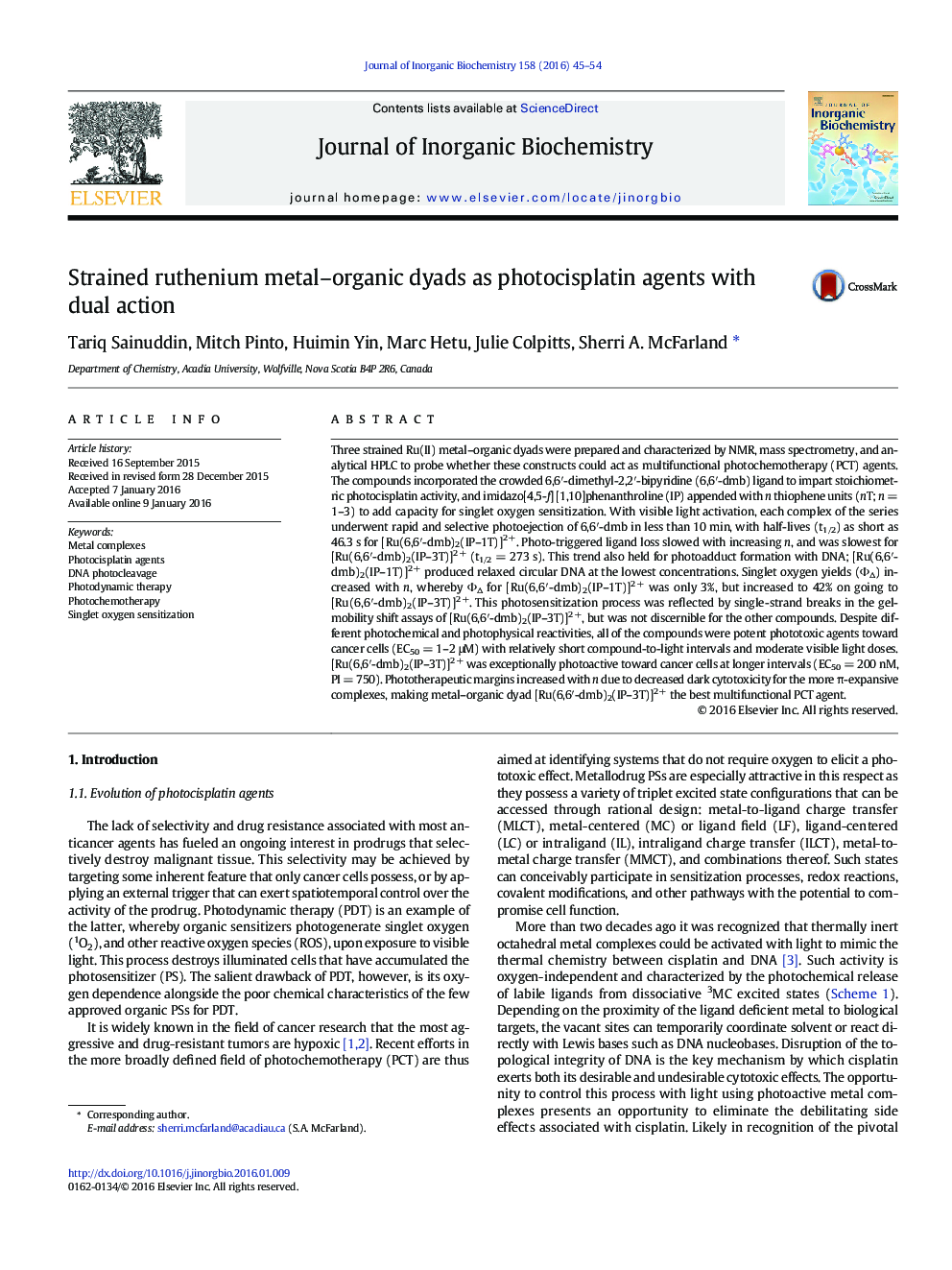| کد مقاله | کد نشریه | سال انتشار | مقاله انگلیسی | نسخه تمام متن |
|---|---|---|---|---|
| 1316836 | 1499429 | 2016 | 10 صفحه PDF | دانلود رایگان |

• Ru(II) adducts were studied as photochemotherapy/photodynamic therapy (PCT/PDT) agents.
• All compounds incorporated two crowded ligands for photo-triggered ligand loss.
• Compounds differed by the number of thiophenes (n) appended to an unstrained ligand.
• Singlet oxygen yields increased and photoejection rates decreased with increasing n.
• The compound with n = 3 acted as a dual PDT/PCT agent.
Three strained Ru(II) metal–organic dyads were prepared and characterized by NMR, mass spectrometry, and analytical HPLC to probe whether these constructs could act as multifunctional photochemotherapy (PCT) agents. The compounds incorporated the crowded 6,6′-dimethyl-2,2′-bipyridine (6,6′-dmb) ligand to impart stoichiometric photocisplatin activity, and imidazo[4,5-f] [1,10]phenanthroline (IP) appended with n thiophene units (nT; n = 1–3) to add capacity for singlet oxygen sensitization. With visible light activation, each complex of the series underwent rapid and selective photoejection of 6,6′-dmb in less than 10 min, with half-lives (t1/2) as short as 46.3 s for [Ru(6,6′-dmb)2(IP–1T)]2 +. Photo-triggered ligand loss slowed with increasing n, and was slowest for [Ru(6,6′-dmb)2(IP–3T)]2 + (t1/2 = 273 s). This trend also held for photoadduct formation with DNA; [Ru(6,6′-dmb)2(IP–1T)]2 + produced relaxed circular DNA at the lowest concentrations. Singlet oxygen yields (ΦΔ) increased with n, whereby ΦΔ for [Ru(6,6′-dmb)2(IP–1T)]2 + was only 3%, but increased to 42% on going to [Ru(6,6′-dmb)2(IP–3T)]2 +. This photosensitization process was reflected by single-strand breaks in the gel-mobility shift assays of [Ru(6,6′-dmb)2(IP–3T)]2 +, but was not discernible for the other compounds. Despite different photochemical and photophysical reactivities, all of the compounds were potent phototoxic agents toward cancer cells (EC50 = 1–2 μM) with relatively short compound-to-light intervals and moderate visible light doses. [Ru(6,6′-dmb)2(IP–3T)]2 + was exceptionally photoactive toward cancer cells at longer intervals (EC50 = 200 nM, PI = 750). Phototherapeutic margins increased with n due to decreased dark cytotoxicity for the more π-expansive complexes, making metal–organic dyad [Ru(6,6′-dmb)2(IP–3T)]2 + the best multifunctional PCT agent.
Strained Ru(II) complexes act as photocisplatin reagents that can be improved further by incorporating π-expansive ligands that sensitize singlet oxygen. Certain compounds are potent multifunctional photochemotherapy/photodynamic therapy (PCT/PDT) agents toward cancer cells.Figure optionsDownload as PowerPoint slide
Journal: Journal of Inorganic Biochemistry - Volume 158, May 2016, Pages 45–54